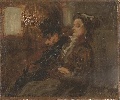Saturday, March 31, 2012 -  Ambroise Vollard,Daumier Register,Erich Schlomovic,Honoré Daumier,IFAR,National Museum of Serbia,provenance
Ambroise Vollard,Daumier Register,Erich Schlomovic,Honoré Daumier,IFAR,National Museum of Serbia,provenance
 No comments
No comments
 Ambroise Vollard,Daumier Register,Erich Schlomovic,Honoré Daumier,IFAR,National Museum of Serbia,provenance
Ambroise Vollard,Daumier Register,Erich Schlomovic,Honoré Daumier,IFAR,National Museum of Serbia,provenance
 No comments
No comments
The Journal of Art Crime, Fall 2011: The Daumier Register
In the Fall 2011 issue of The Journal of Art Crime, Lilian and
Dieter Noack of the Daumier Register announced that they had pinned down the the location of two
paintings by the French painter and lithographer Honoré Daumier (1808-78) whose whereabouts had been previously unknown to the Swiss-based website that has the
mission of identifying the works of the satirist of French society and politics.
The Daumier Register keeps a list of "Lost and Missing Paintings" and "Stolen and Looted Paintings".
 |
| Daumier's oil painting, "Femme avec deux enfants" |
Daumier’s (“Femme avec deux enfants” / “Mother with her children” (numbered as DR7196 in the Daumier Register) is an oil
painting (1865/68) that has been in the collection of the National Museum of Serbia in Belgrave, Serbia, since 1949, according to the Noacks, founders of the Daumier register, who report that "rumours about the theft of the picture are thus unfounded." The painting was reportedly owned by Ambroise Vollard, a Parisian art dealer who died in an auto accident in 1939 whose assistant Erich Schlomovic, a young Croatian Jew, exhibited the painting in Zagreb in 1940. The painting was also exhibited in Prague, 1971; Zagreb again in 1989-90; Japan, 2005-6; and in Como, Italy, in 2007. The communist government of Yugoslavia incorporated the painting into the state's collection after World War II. [Schlomovic was murdered at the age of 27 in a mobile gas chamber in 1942).
The National Museum of Serbia in Belgrade closed its permanent collection on June 1, 2003, for a reconstruction.
 |
| Daumier's "Third Class" |
The second painting, DR9119 (“Un wagon de troisième classe “ /
“Third Class “ / “Wagen dritter Klasse’) had disappeared after it
had been sold in 1982 at Drouot Auction in Paris. It was part of two Daumier
paintings (the second being DR7005), which belonged to the estate of Parisian industrialist Roger Leybold (1896-1970) and shows an
interesting Third Class Carriage scene, according to the Daumier Register. "We were informed by the owners that it was offered for sale in 2011 by Galerie AB in Paris where it had been stored since 1982," Daumier Register reported. You may read more about the background of this painting here.
The International Foundation for Art Research (IFAR) lists sources, including the Daumier Register, to obtain information on the body of work (catalogues raisonnés) for Honoré Daumier.
The International Foundation for Art Research (IFAR) lists sources, including the Daumier Register, to obtain information on the body of work (catalogues raisonnés) for Honoré Daumier.


